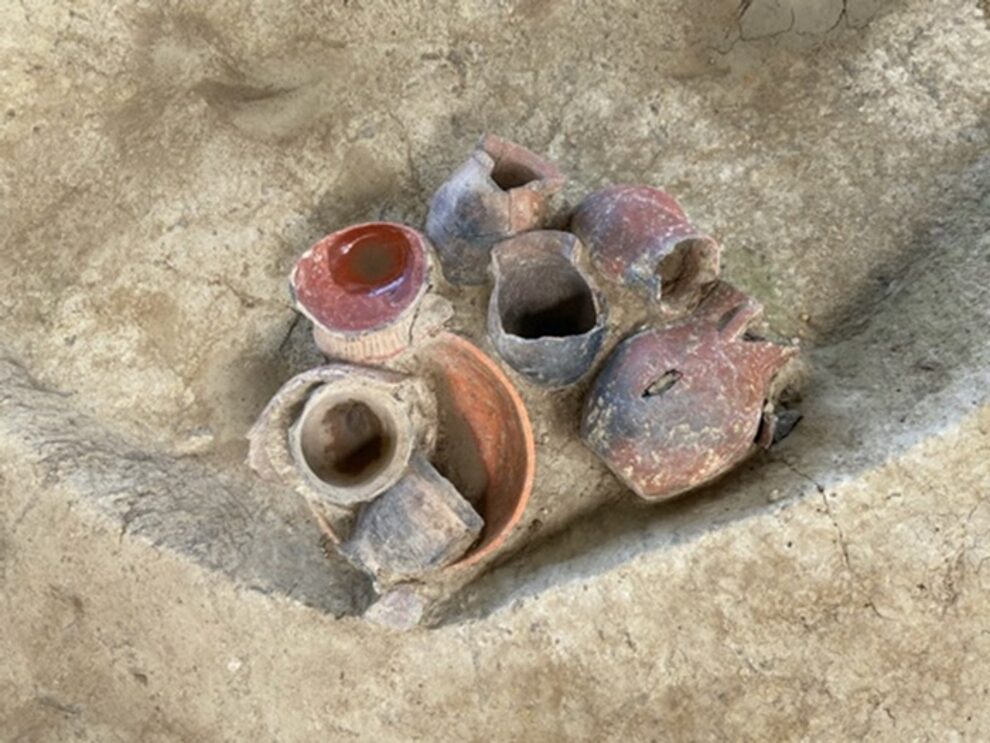According to the researchers, including Jiajing Wang from Dartmouth College in the US, this kind of ritual drinking 9,000 years ago may have played an important role in "maintaining social relationships and paving the way for the rise of complex farming societies four millennia later".
In the study, published last week in the journal PLOS ONE, the scientists unearthed some of "the earliest known painted pottery in the world", of which some were also decorated with abstract designs.
The pottery were found in a platform mound - 80m x 50m wide, with an elevation of 3 m above ground level - surrounded by a human-made ditch.
"No pottery of this kind has been found at any other sites dating to this time period," the scientists noted in a statement.
Each of the pots, the archaeologists say, could be held in one hand like a cup unlike storage vessels, which are much larger in size.
Seven of the 20 vessels appeared to be long-necked Hu pots which were used to drink alcohol in later historical periods, the study noted.
The scientists then analysed the fossil residues extracted from the surface of the pots, and compared them with control samples obtained from soil surrounding the vessels.
They identified starch granules, fossilised remains of rice husks, other plants, mould, and yeast residues in the pots - consistent with residues from beer fermentation and not found naturally in soil or in other artefacts unless they had contained alcohol.
The mould found in the pots at Qiaotou is very similar to that which is present in koji, which is used to make sake and other fermented rice beverages in East Asia, the researchers explained.
According to the archaeologists, the findings predate earlier research, which found that mould had been used in fermentation processes 8,000 years ago in China.
"Through a residue analysis of pots from Qiaotou, our results revealed that the pottery vessels were used to hold beer, in its most general sense - a fermented beverage made of rice (Oryza sp.), a grain called Job's tears (Coix lacryma-jobi), and unidentified tubers," Ms Wang said in a statement.
"This ancient beer though would not have been like the IPA that we have today. Instead, it was likely a slightly fermented and sweet beverage, which was probably cloudy in colour," she added.
The archaeologists add that making the fermented beverage may not have been easy, since rice crops were still in their early phases of domestication during this time 9,000 years ago.
They believe most communities of this time were hunter-gatherers who relied primarily on foraging and the beer made at Qiaotou was likely a ritually significant beverage.
Comment: There's evidence of the advanced civilization of Gobekli Tepe in Turkey that predates this site by some 2,000 years, and so isn't it possible that this society was equally advanced? Prehistoric cave art study reveals ancient people had complex knowledge of astronomy and were tracking catastrophic meteor showers
"We don't know how people made the mould 9,000 years ago, as fermentation can happen naturally. If people had some leftover rice and the grains became mouldy, they may have noticed that the grains became sweeter and alcoholic with age," Ms Wang said.
"While people may not have known the biochemistry associated with grains that became mouldy, they probably observed the fermentation process and leveraged it through trial and error," she added.




Comment: A discovery in Siberia revealed a 16,000 year-old cooking pot, which is also considered to be the world's oldest, whilst Aboriginals in Australia may have been baking bread for nearly 30,000 years.
See also:
- 26,000 year old, most northerly settlement of Palaeolithic era found on Kotelny island in the Arctic, evidence of butchered mammoth bones found
- 7,200 year old evidence of cheese making found in neolithic village in Croatia may be oldest yet
- Evidence of peaceful prehistoric Japanese hunter-gatherers shows violence and warfare were uncommon
- 25 ancient tombs with encased skulls found in China's Guizhou
- Jomon woman living in Japan 3,800 years ago had high fat diet and high alcohol tolerance
- Researcher thinks China's pyramids encode astronomical alignments
And check out SOTT radio's: MindMatters: America Before: Comets, Catastrophes, Mounds and Mythology